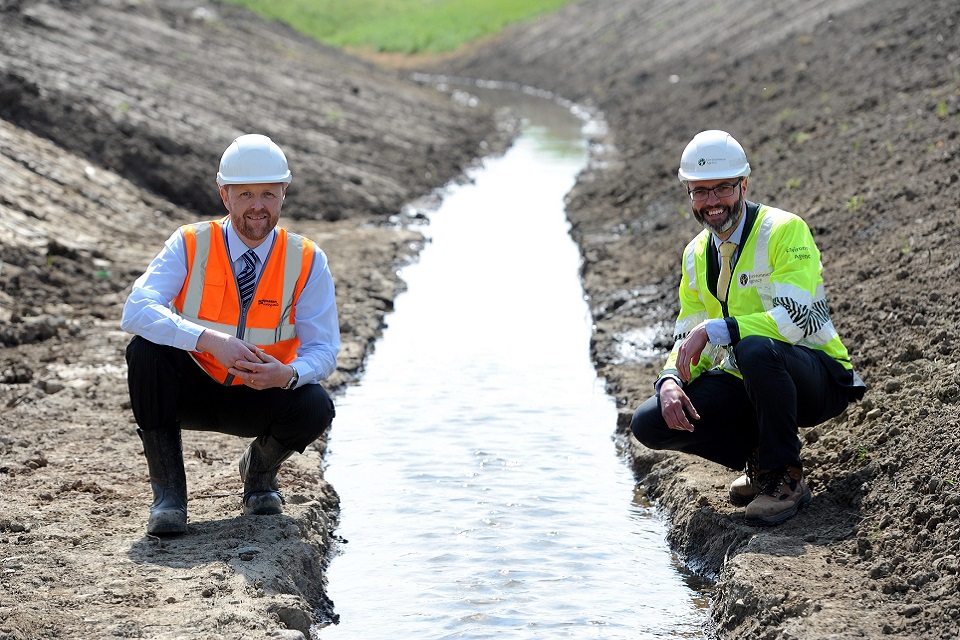A flood and coastal group will oversee spending of almost £22million to protect hundreds of homes across the north east as it sets out its objectives for the next year.
The Northumbria Regional Flood and Coastal Committee (NRFCC) has launched its business plan for 2017/18, which will include continued work at Greatham in Hartlepool, Killingworth in North Tyneside, Hartlepool Headland Coastal Protection Scheme, improvements to the Central Promenade at Whitley Bay, and Monkton Village Flood Alleviation Study in South Tyneside.
It will better protect around 743 properties from flood risk and another 100 from coastal erosion.
It also announced in its 2016/17 annual report that it’s overseen 110 projects costing £24.5million over the past year, reducing the risk of flooding and coastal erosion to 1,291 properties.
Projects include Lustrum Beck flood alleviation scheme in partnership with Stockton Borough Council which better protects over 150 properties, and the Brunton Park scheme in partnership with Northumbrian Water and Newcastle City Council, which addressed sewer flooding issues and reduces the risk of flooding from the Ouseburn.
And a dam on the Cotting Burn, the final part of the significant £28million Morpeth flood alleviation scheme which protects 1,000 homes and business in the town, was completed.
The dam has been renamed ‘The Hargreaves Dam’ in memory of Jon Hargreaves, NRFCC Chairman who sadly passed away last October.

Third year of six-year programme
The past year has also seen the completion of a £3million repair programme following the devastating floods during Storm Desmond in December 2015.
The annual report and business plan together summarise the past year and look forward to the year ahead.
It is the third year of a six-year programme of work which was agreed in January 2015. The business plan will be updated each year to take into account any adjustments to the £108million, six-year programme, which will better protect a total of 5,300 properties once complete.
Leila Huntington, Flood and Coastal Risk Manager with the Environment Agency in the North East, said:
On completion of our £22million programme of work for the coming year, we will see a reduction in flood and coastal risk to around 843 homes and businesses in the region, as well as creating 30 hectares of new water dependent wildlife habitat.
The committee is a great example of true partnership working, with all local councils, the Environment Agency and Northumbrian Water pulling together on behalf of communities in the north east.
It has an essential role to play in developing and completing flood risk management projects which reflect local priorities and understand the needs of communities.
This is the third year of our six-year programme – so far we have already better protected 2,045 properties, bringing significant benefits to communities, properties, businesses and the environment, and this work will continue.

Partnership working
Most projects in the plan are carried out by the Environment Agency and local authorities, with some carried out by, or in partnership with Northumbrian Water.
Councillor Nick Oliver, Northumberland County Council’s NRFCC member, said:
The Morpeth scheme is a great example of agencies working together on a hugely ambitious engineering project and the fact it has already been used more than proves its worth.
One of the cornerstones of the scheme has been the help and support of the local community, and their input and engagement has been absolutely invaluable throughout.
In Northumberland we are only too aware of the devastating effects of flooding and we welcome this latest plan which details continuing investment in schemes to protect communities across the region.
The Brunton Park scheme, which was completed last year, involved creating a new river channel to divert the River Ouseburn and, by using the old channel as a new storage basin, creating a valuable habitat for wildlife. It also involved the construction of flood defences, the installation of two kilometres of new sewer pipe and a new storage tank.
Richard Warneford, Northumbrian Water Group’s Wastewater Director, said:
Tackling flooding and improving the resilience of our sewer network are key priorities for us. We know that being flooded is a truly awful experience for our customers and we work tirelessly to reduce the risk of this happening. By working in partnership with the Environment Agency and local authorities we can tackle flooding from all sources.
The Brunton Park scheme is an excellent example of partnership work. By drawing upon the experience and expertise of all our partners, an innovative and creative solution was agreed that enabled us to manage surface water in the natural environment.
I am extremely proud of our partnership approach which resulted in reducing the risk of flooding to our customers and the community. We will certainly be able to build on the experience of delivering this project for future schemes.
The NRFCC receives funding from a variety of sources, including from Government Grant-in-Aid, public and private contributions and a levy raised through local authorities.
The committee consists of elected and independent members and plays an important part in deciding local priorities for the flood and coastal risk management programme in North East England.
Anyone who would like a copy of the business plan and annual report can email nrfcc@environment-agency.gov.uk
Follow this news feed: Environment Agency





